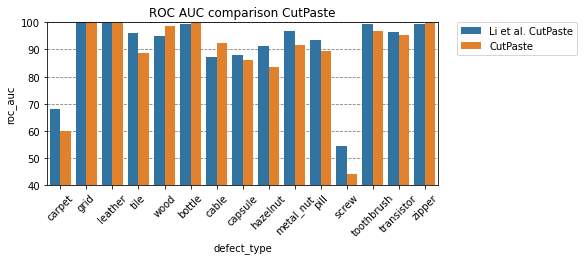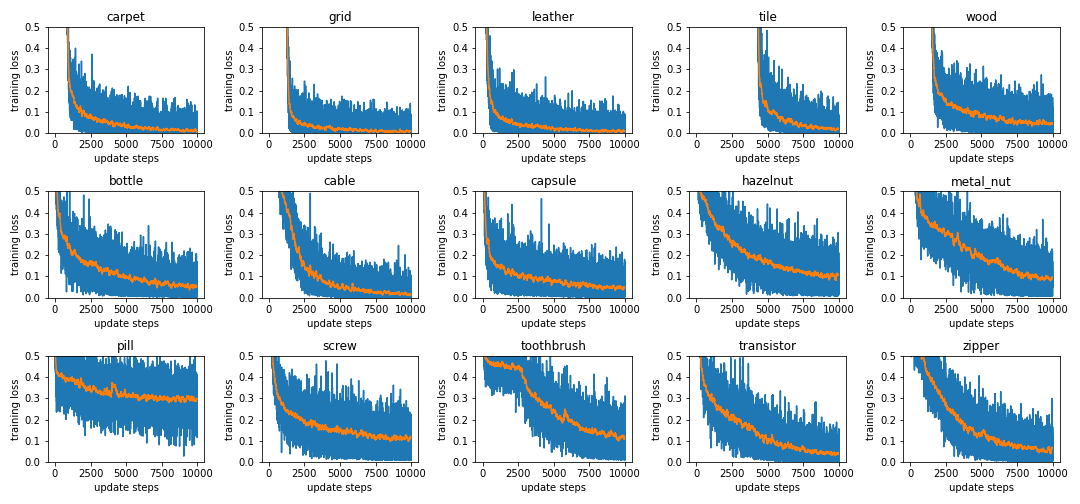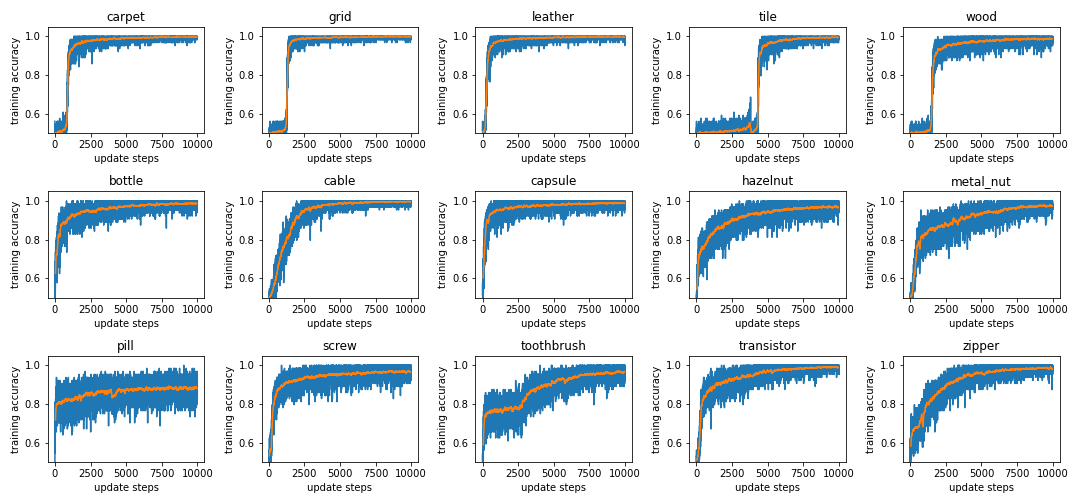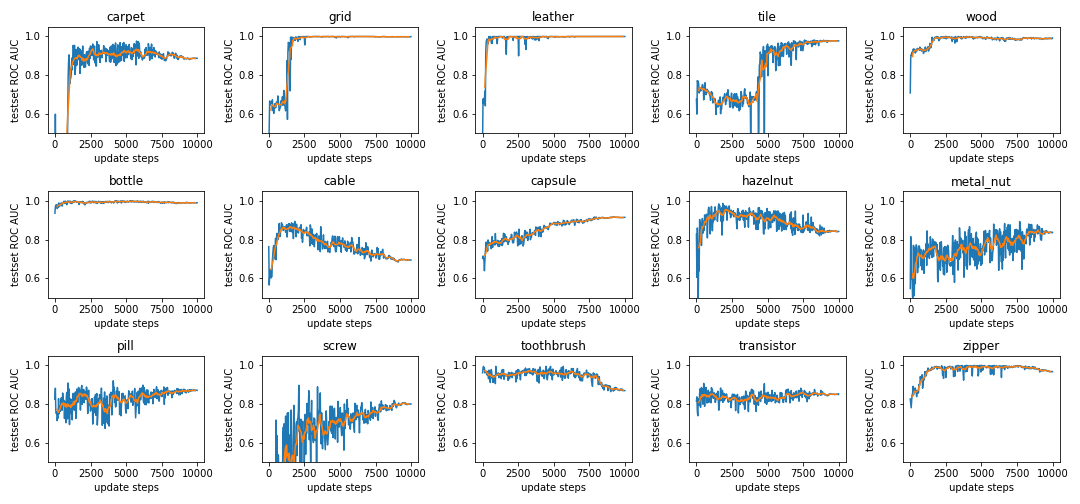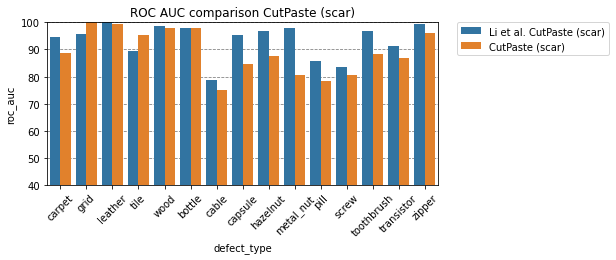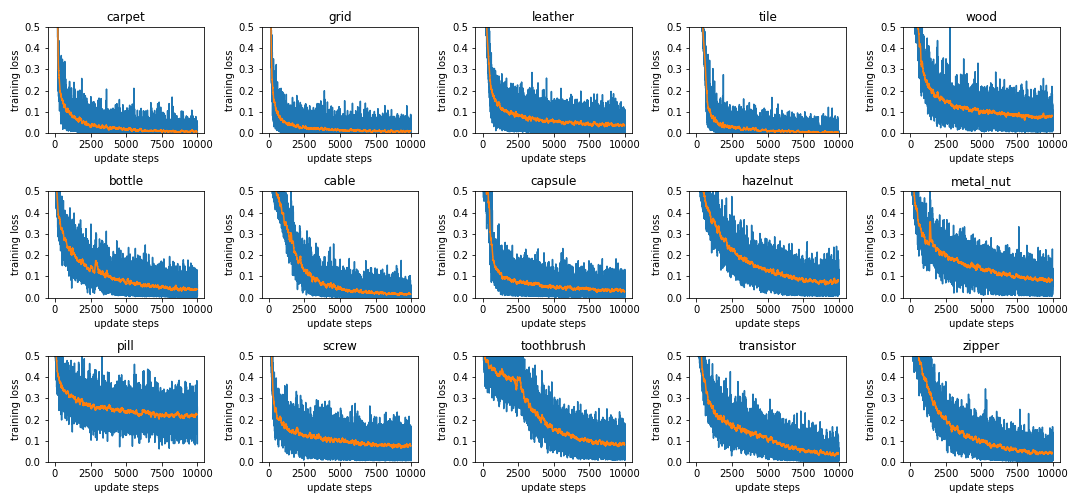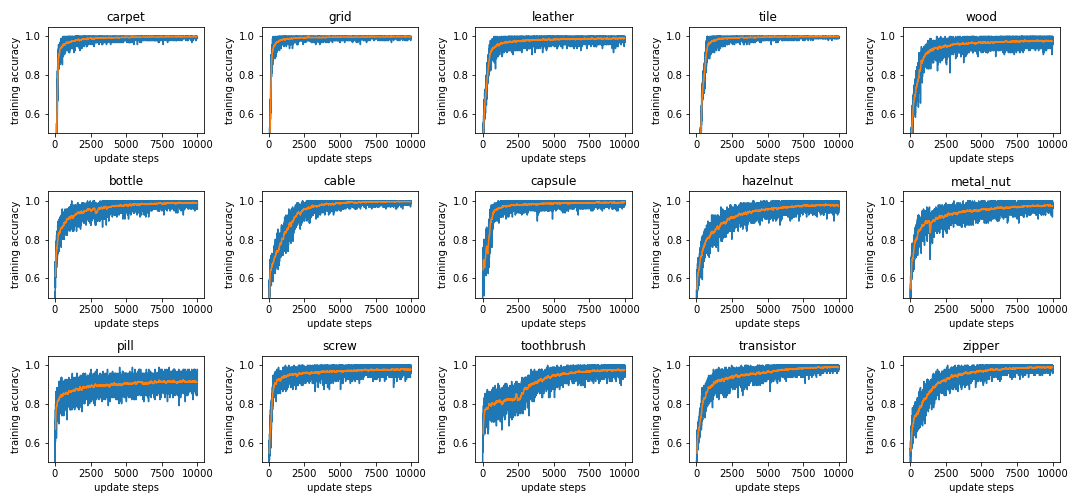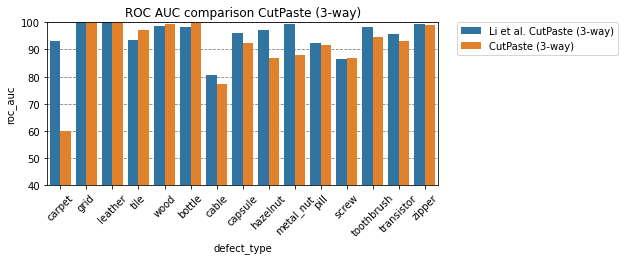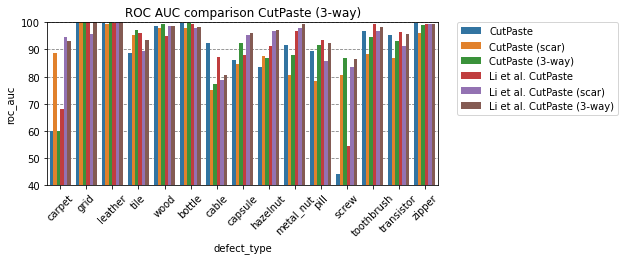This is an unofficial work in progress PyTorch reimplementation of CutPaste: Self-Supervised Learning for Anomaly Detection and Localization and in no way affiliated with the original authors. Use at own risk. Pull requests and feedback is appreciated.
Download the MVTec Anomaly detection Dataset from here and extract it into a new folder named Data.
Install the following requirements:
- Pytorch and torchvision
- sklearn
- pandas
- seaborn
- tqdm
- tensorboard
For example with Anaconda:
conda create -n cutpaste pytorch torchvision torchaudio cudatoolkit=10.2 seaborn pandas tqdm tensorboard scikit-learn -c pytorch
conda activate cutpaste
python run_training.py --model_dir models --head_layer 2
The Script will train a model for each defect type and save it in the model_dir Folder.
One can track the training progress of the models with tensorboard:
tensorboard --logdir logdirs
python eval.py --model_dir models --head_layer 2
This will create a new directory Eval with plots for each defect type/model.
The pasted image patch always origins from the same image it is pasted to. I'm not sure if this is a Problem and if this is also the case in the original paper/code.
Li et al. define "256 parameter update steps" as one epoch. The --epoch parameter takes the number of update steps and not their definition of epochs.
Li et al. use a "batch size of 64 (or 96 for 3-way)". Because the number of images feed into the model changes from the normal to the 3-way variant I suspect that they always start with 32 images that get augmented. The --batch_size parameter specifies the number of images read from disk. So for the all variants --batch_size=32 should correspond with the batch size used by Li et al.
I did not find a model description of the projection head Li et al. use.
The --head_layer parameter is used to vary the number of layers used in this implementation.
Actually head_layer + 2 fully connected layers are used.
Starting with head_layer layers with 512 neurons, followed by a layer with 128 neurons and the output layer with 2 or 3 neurons. The number of neurons depends on the variant. 2 for normal and scar and 3 for 3way.
Li et al. "apply random translation and color jitters for data augmentation". This implementation only applies color jitter before the CutPaste augmentation. I tried to use torchvision.transforms.RandomResizedCrop as translation, but in a brief test I did not find that it improves performance.
Li et al. use tensorflow for their implementation. This implementation is using PyTorch.
This implementation only tries to recreate the main results from section 4.1 and shown in table 1.
python run_training.py --epochs 10000 --test_epochs 32 --no-pretrained --cuda 1 --head_layer 1 --batch_size 32 --variant normal
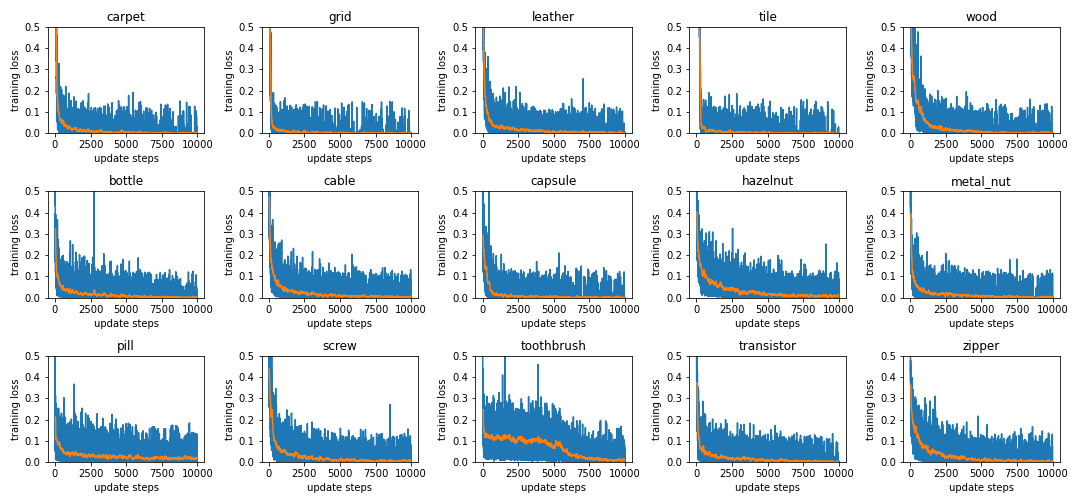 The blue line is the real value and the orange line is an average over 100 epochs.
The blue line is the real value and the orange line is an average over 100 epochs.
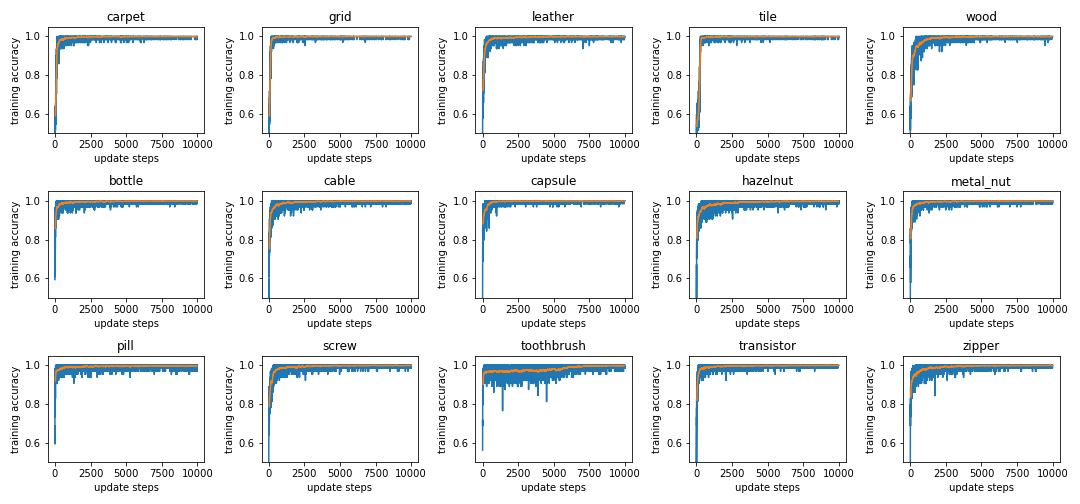
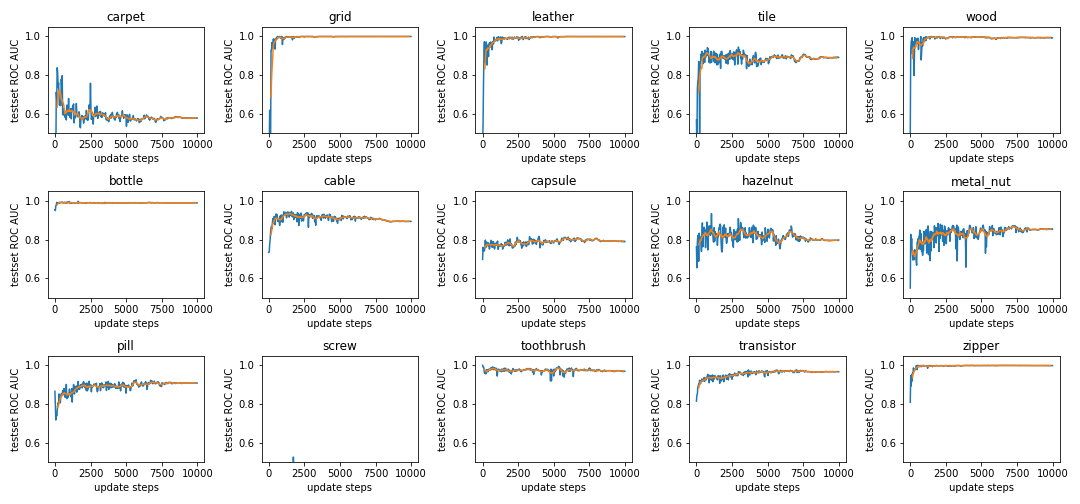 We only run the ROC AUC every 32nd update step, here the orange line is an average over 320 update steps (10 ROC AUC values).
Note: The validation accuracy (named test set ROC AUC) is using the Mahalanobis distance as anomaly score. It can not be directly compared with the accuracy during training.
We only run the ROC AUC every 32nd update step, here the orange line is an average over 320 update steps (10 ROC AUC values).
Note: The validation accuracy (named test set ROC AUC) is using the Mahalanobis distance as anomaly score. It can not be directly compared with the accuracy during training.
Note that for readability, the y-axis starts at 40% AUC ROC.
python run_training.py --epochs 10000 --test_epochs 32 --no-pretrained --cuda 1 --head_layer 1 --batch_size 32 --variant scar
Due to limited computing resources, the evaluation during training is disabled.
python run_training.py --epochs 10000 --test_epochs -1 --no-pretrained --cuda 1 --head_layer 1 --batch_size 32 --variant 3way
| defect_type | CutPaste | Li et al. CutPaste | CutPaste (scar) | Li et al. CutPaste (scar) | CutPaste (3-way) | Li et al. CutPaste (3-way) |
|---|---|---|---|---|---|---|
| bottle | 99.7 | 99.2 | 97.9 | 98.0 | 99.6 | 98.3 |
| cable | 92.3 | 87.1 | 75.0 | 78.8 | 77.2 | 80.6 |
| capsule | 86.2 | 87.9 | 84.5 | 95.3 | 92.4 | 96.2 |
| carpet | 59.8 | 67.9 | 88.6 | 94.6 | 60.1 | 93.1 |
| grid | 100.0 | 99.9 | 99.9 | 95.5 | 100.0 | 99.9 |
| hazelnut | 83.7 | 91.3 | 87.5 | 96.7 | 86.8 | 97.3 |
| leather | 99.5 | 99.7 | 99.5 | 100.0 | 100.0 | 100.0 |
| metal_nut | 91.5 | 96.8 | 80.6 | 97.9 | 87.8 | 99.3 |
| pill | 89.4 | 93.4 | 78.4 | 85.8 | 91.7 | 92.4 |
| screw | 44.1 | 54.4 | 80.7 | 83.7 | 86.8 | 86.3 |
| tile | 88.7 | 95.9 | 95.3 | 89.4 | 97.2 | 93.4 |
| toothbrush | 96.7 | 99.2 | 88.3 | 96.7 | 94.7 | 98.3 |
| transistor | 95.1 | 96.4 | 86.8 | 91.1 | 93.0 | 95.5 |
| wood | 98.6 | 94.9 | 98.0 | 98.7 | 99.4 | 98.6 |
| zipper | 99.6 | 99.4 | 95.9 | 99.5 | 98.8 | 99.4 |
| average | 88.3 | 90.9 | 89.1 | 93.4 | 91.0 | 95.2 |
- implement Cut-Paste Scar
- implement gradCam
- implement localization variant
- add option to finetune on EfficientNet(B4)
- clean up parameters and move them into the arguments of the scripts
- compare results of this reimplementation with the results of the paper
